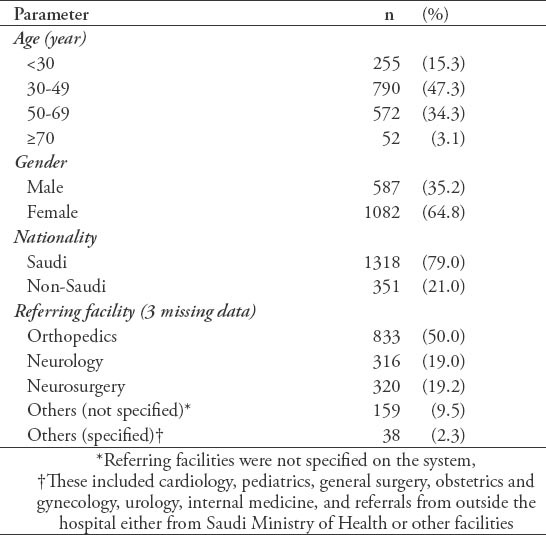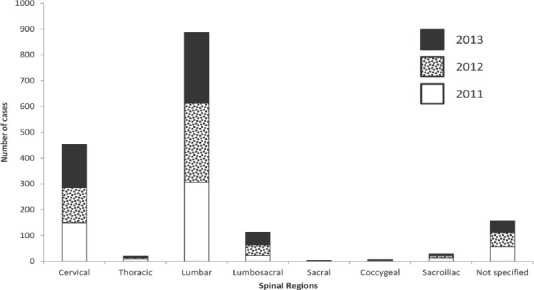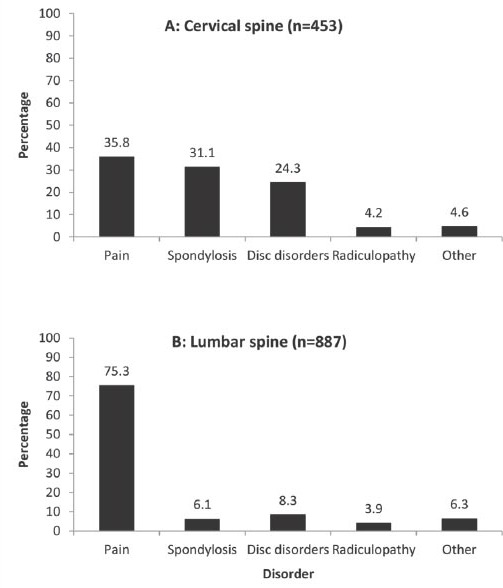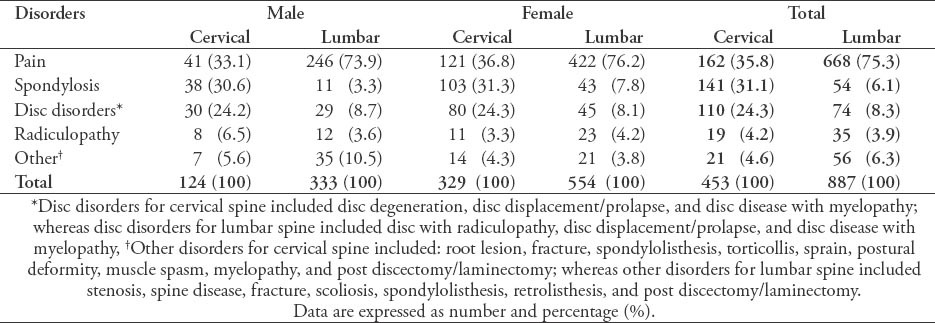Abstract
Objectives:
To establish the period prevalence of spinal disorders referred to physical therapy in a university hospital over a 3-year period, and to determine the relationships of common spinal disorders with patients’ age and gender.
Methods:
This retrospective study was conducted in the Physical Therapy Department, King Fahd Hospital of the University, Dammam, Saudi Arabia. Computer data of all new electronic referrals from January 2011 to December 2013 were retrieved and reviewed. The computer data included demographic information, referring facility, and diagnosis/disorder.
Results:
One thousand six hundred and sixty-nine (28.1%) of all referred patients (5929) had spinal disorders. The most common disorders affected the lumbar spine (53.1%) and cervical spine (27.1%), and pain was the most common disorder. Neck pain (60.5%) was more common in patients <30 years old (p<0.001). Cervical spondylosis was common (~30%) in the >30 age groups. Spondylosis and low back pain were more prevalent in women (7.8% and 76.2%) than in men (73.9% and 3.3%).
Conclusion:
Spinal disorders were common compared with other disorders. Low back pain and neck pain were the most common spinal disorders. Age and gender were weakly related to some of the disorders that affected the lumbar and cervical spine.
Spinal disorders include a wide and heterogeneous spectrum of diseases that affect the vertebrae, intervertebral discs, facet joints, tendons, ligaments, muscles, spinal cord, and nerve roots of the spine.1 Spinal disorders are classified based on etiology (namely, specific and non-specific spinal disorders) or according to the time course of the symptoms (namely, acute, subacute, or chronic).1 Specific spinal disorders have clear etiologies and can be diagnosed based on specific structural pathologies and clinical pictures (10-15%), whereas non-specific spinal disorders are primarily pain syndromes and are difficult to relate to pathomorphological sources. Most spinal disorders (ranging from 85-90%) are classified as non-specific.1 Spinal disorders can include, but are not limited to pain syndromes, disc degeneration, spondylosis, radiculopathy, stenosis, spondylolisthesis, fractures, tumors, and osteoporosis. Spinal disorders have enormous economic and psychosocial effects. For example, low back pain (LBP) is a common spinal disorder and is the most common cause of disability in the population of the USA younger than 45 years old, the second most common reason for visits to a physician, the fifth most common cause of hospital admission, and the third most frequent cause of surgery.2 Despite this fact, research investigating the epidemiology of these disorders is in its early stages relative to other disorders such as cancer and cardiovascular disorders.3 Physical therapy is a “healthcare profession that assesses, diagnoses, treats, and works to prevent disease and disability through physical means.”4 “Physical therapists, doctors, and other health professionals often work as part of a team that plans and tailors treatment for a specific condition.”4 Physical therapists address patients with numerous diagnoses, including those affecting the spine. In Australia and the USA, physical therapists are the first-contact practitioner, which means that a physician’s referral is not required for a patient to be treated by a physical therapist. In contrast, in Saudi Arabia, patients seeking physical therapy care need to be referred by a physician. Literature review revealed a lack of studies on the prevalence of the diagnoses and characteristics of patients with spinal conditions who are referred to physical therapy clinics in Saudi Arabia or even worldwide. Identifying the prevalence of spinal disorders can help guide resource allocation and subsequently improve the quality of care. Therefore, the current study aimed to 1) establish the period prevalence of spinal disorders that lead to referrals to the physical therapy clinic of a university hospital in Saudi Arabia, and 2) determine whether the patients’ ages and genders play roles in the prevalence of the common spinal disorders.
Methods
This retrospective study was conducted at the Department of Physical Therapy, King Fahd Hospital of the University (KFHU), Alkhobar, Saudi Arabia. This department provides care to out- and in-patients from various specialties within the hospital and from other hospitals. Physical therapy services are provided to male and female patients daily. The KFHU has 600 beds and comprises 38 departments and clinics.5 Ethical approval for this study was obtained from the Standing Committee for Research Ethics on Living Creatures at the University of Dammam.
Computer data from all the new (first visit) electronic referrals of patients attending the Department of Physical Therapy at KFHU over the 3-year period between January 2011 and December 2013 were retrieved and reviewed. The computer data used for the current study were only from the out-patient section. The retrieved data included demographic information (namely, nationality, gender, and age), the referring facility, and a diagnosis/disorder. Physicians referred some patients to physical therapy with the same disorder more than once. Therefore, data from patients with repeated disorders were excluded. Some disorders were re-coded from group similar terms into a unified term. For example, the term ‘post C4-C5 and C5-C6 discectomy’ and the term ‘post laminectomy C2-C3’ were re-coded as ‘post cervical discectomy/laminectomy’. Another example is that the terms ‘backache’, ‘back pain’, and ‘low back pain’ were re-coded as ‘low back pain’. The disorders were categorized based on the spinal region as follows: cervical, thoracic, lumbar, lumbosacral, sacral, coccygeal, sacroiliac, and other (unspecified region).
Statistical analyses
Statistical analysis was performed by the IBM SPSS Statistics for Windows version 19.0 (IBM Corp, Armonk, NY, USA). To identify the case prevalence, descriptive statistics of the frequencies in the data were computed. Chi-square with Cramer’s V tests (rectangular tables) were used to investigate the relationships of the most common spinal disorders with age and gender. The level of statistical significance for these relationships was set at p<0.05.
Results
The physicians referral has a total of 5,929 out-patient cases to the Department of Physical Therapy at KFHU over a 3-year period (year 2011: 1939, year 2012: 1943, and year 2013: 2047). Of these, 1,669 (28.1%) cases had spinal disorders. Table 1 illustrates the demographic characteristics of this population. Notably, approximately 50% of patients were in the 30-49 year-old age group, two-thirds were female, three-quarters were Saudis, and 50% were referred from the orthopedic department within the hospital.
Table 1.
Demographic characteristics of studied data among 1669 patients referred to the physical therapy department.

Figure 1 shows a breakdown of numbers of disorders as categorized by spinal region. The most common disorders that were referred affected the lumbar spine (53.1%), cervical spine (27.1%); together, these regions represented 80.2% of all referrals. Combining the disorders related to the lumbosacral region (6.7%) with those related to the lumbar spine caused the percentage of disorders affecting the lumbar spine to increase to approximately 60%. Figure 2 shows the common disorders that affected both the cervical and lumbar spines. Low back pain represented three-quarters of the disorders that affected the lumbar spine, and other disorders (such as spondylosis, disc disorders, and radiculopathy) did not exceed 10%. In contrast, the most common disorders related to the cervical spine were pain (36.8%), spondylosis (31.3%), and disc disorders (24.3%).
Figure 1.

Numbers of disorders categorized by spinal region and year.
Figure 2.

Common disorders affecting both the A) cervical and B) lumbar spines. Pain was the most common disorder that affected both the cervical and lumbar spines.
Table 2 shows the relationships between the patients’ age and the common spinal disorders of the cervical and lumbar spines. There was a weak, but statistically significant relationship between age and cervical spine disorders [Chi-square: x2=54.73, df=12, Cramer’s V=0.20, p<0.001]. Notably, neck pain (60.5%) was more common in patients below the age of 30 years than in older patients. The prevalence of cervical spondylosis was approximately 30% in the age groups <30 years. There was a stepwise increase in the prevalence of cervical disc disorders with increasing age; this prevalence ranged from 11.6% (age >30 years) to 38.5% (age ≥70 years). No statistically significant relationship was found between age and lumbar spine disorders [Chi-square: χ2=13.155, df=12, Cramer’s V=0.07, p=0.358].
Table 2.
Common spinal diagnoses/disorders of cervical and lumbar spines among 1340 patients and their relation to patients’ age.

Table 3 illustrates the relationships between patient gender and the common spinal disorders of the cervical and lumbar spines. There was no relationship between gender and cervical spine disorders [chi-square: χ2=2.81, df=4, Cramer’s V=0.08, p=0.590]. There was a statistically significant relationship between gender and lumbar spine disorders, although this relationship was weak [Chi-square: χ2=22.06, df=4, Cramer’s V=0.16, p<0.001]. Low back pain (76.2%) and spondylosis (7.8%) seemed to be more prevalent in female patients than in male patients (LBP 73.9% and spondylosis 3.3%). “Other” disorders were less prevalent in female (3.8%), than in male (10.5%) patients.
Table 3.
Common spinal diagnoses/disorders of cervical and lumbar spines among 1340 patients and their relation to patients’ gender.

Discussion
The findings revealed that 28.1% of patients had spinal disorders. Most commonly affected was the lumbar spine (53.1%) followed by the cervical spine (27.1%). Low back pain (75.3%) was the most common disorder that affected the lumbar spine. Pain (36.8%), spondylosis (31.3%), and disc disorders (24.3%) were the most common disorders that affected the cervical spine. Generally, weak relationships of age and gender with some of the disorders of the lumbar and cervical spines were found.
As noted, neck, and LBP were the most common disorders of the cervical and lumbar spines. In a population-based study of 34,902 adult Danish twins, Leboeuf-Yde et al6 found that LBP was the most common followed by the neck pain and then thoracic pain. The 3-month prevalence of back, or neck pain was 31% in a population-based survey of US adults >18 years.7 Elfering and Mannion1 reported that neck pain and LBP were the most common symptoms among non-specific spinal disorders. Work-related disability from non-specific spinal disorders is epidemic, and although only a minority of the patients are chronically disabled, these patients are responsible for most of the care costs.1 The lifetime prevalence of LBP was reported to be 75-85%, the 12-month prevalence was 15-45%, the 12-month incidence was as high as 20%, and the yearly recurrence rate was reported to be as high as 60%.1 A recent systematic review of the global prevalence of LBP found that the point prevalence was 11.9% and the one-month prevalence was 23.2%.8 In a systematic review of 56 epidemiological studies of a world population, Fejer et al9 found that neck pain was common with a mean point (namely, at any given time) prevalence of 7.6%, a mean one-week prevalence of 12.5%, a mean one-month prevalence of 23.3%, a mean 6-month prevalence of 29.8%, a mean one-year prevalence of 37.2%, and a mean lifetime prevalence of 48.5%.9 Cervical spondylosis occurred in 13.1% of 47,560 patients who were included in a study from USA between 2006 and 2011.10 They observed a prevalence of cervical spondylosis in 31% patients with thoracolumbar spinal deformities.10
The present study revealed that neck pain (60.5%) was more common among patients <30 years than in older patients. A systematic review11 identified studies of idiopathic adolescent spinal pain and found that spinal pain was the most commonly reported measure with a lifetime prevalence that ranged from 4.7-74.4%. The lifetime prevalence of LBP in adolescents ranges from 7-72%.11 A national prevalence study from the USA, found that LBP, neck pain, and LBP and neck pain were more common in women and among older age groups.7 Neck pain and LBP exhibited a mild peak near middle age.6 Our study found that LBP was more prevalent in female patients than in male patients. This finding supports the findings of the systematic review of the global prevalence of LBP conducted by Hoy et al8 and the findings of a Danish study by Leboeuf-Yde et al.6 The current study also found that lumbar spondylosis was more prevalent in women than in men. A Japanese cohort study12 that included 2288 participants aged >60 years found that the prevalences of radiographic spondylosis with Kellgren/Lawrence (KL) grade >2 at the severest intervertebral level was 75.8% and grade >3 was 50.4%. This prevalence was 28.8% in patients with LBP. Interestingly, KL >2 spondylosis was more prevalent in men, whereas KL >3 spondylosis and LBP were more prevalent in women. Although KL 2 spondylosis was not significantly more strongly associated with LBP than KL 0 or KL 1 spondylosis, KL >3 spondylosis was related to pain only in the female patients.12
Spinal disorders that lead to referrals to physical therapy, particularly disorders affecting the lumbar and cervical spines, are common. This information might help practitioners and decision-makers to direct their resources to provide special care for patients with these disorders to improve the quality of care and lower costs. Several methods might achieve such improvements. Paskowski et al13 implemented a multidisciplinary spine care pathway that utilizes an evidence-based standardized process and observed improvements in the clinical outcomes and reductions in costs associated with diagnosis and treatment. Personalized and coordinated multidisciplinary care target the biopsychosocial aspects of improving health care and reduce costs.14 A recent systematic review15 concluded that physical therapy via direct access improved patient outcomes and decreased costs compared with referral-based physical therapy.
Study limitations
The limitation of our study was that the computer data lacked some important demographic data, such as patients’ weights and heights, smoking histories, marital statuses, and occupations. Research has shown that these demographic features are associated with spinal disorders, particularly LBP and neck pain.16 The referring physicians used different terms for the same disorders; ‘backache’ and ‘lumbago’ or ‘radiculopathy’ and ‘radicular syndrome.’ Therefore, we re-coded such similar term into unified terms that might influenced the results as this re-coding was subjective.
The current study established evidence on the prevalence of spinal disorders and their relationships with age and gender in patients who were referred to a physical therapy clinic. Approximately 28% of patients had spinal disorders. More than half of these disorders affected the lumbar spine and more than a quarter affected the cervical spine. Low back pain was the most common disorder that affected the lumbar spine, whereas pain, spondylosis, and disc disorders were the most common disorders that affected the cervical spine. Weak relationships of age and gender with some of these disorders were found. Studies from other institutions and other nations will enhance our knowledge in this area of research. Additionally, further research might investigate the mechanisms of the risk factors and preventive outcome measures for common spinal disorders.
Acknowledgment
The author is grateful to Prof. Sulaiman Bah for his valuable help in data analysis. Also thanks to Dr. Saad Alsaadi and Mr. Hani Alkhawajah for reviewing the manuscript.
Footnotes
Related Articles.
Elgamal EA, Elwatidy SM, Alhabib AF, Jamjoom ZB, Murshid WR, Hassan HH, et al. Agenesis of the corpus callosum associated with spinal open neural tube defect. Saudi Med J 2014; 35 Suppl 1: S57-S63.
Elgamal EA, Hassan HH, Elwatidy SM, Altwijri I, Alhabib AF, Jamjoom ZB, et al. Split cord malformation associated with spinal open neural tube defect. Saudi Med J 2014; 35 Suppl 1: S44-S48.
Al-Jadid M, Robert AA. An analysis of the length of stay in traumatic and non-traumatic spinal cord injured patients. A rehabilitation unit experience in Saudi Arabia. Saudi Med J 2010; 31: 555-559.
References
- 1.Elfering A, Mannion AF. Epidemiology and risk factors of spinal disorders. In: Boos N, Aebi M, editors. Spinal disorders: fundamentals of diagnosis and treatment. Berlin (DE): Springer; 2008. [Google Scholar]
- 2.Andersson GB. Epidemiological features of chronic low-back pain. Lancet. 1999;354:581–585. doi: 10.1016/S0140-6736(99)01312-4. [DOI] [PubMed] [Google Scholar]
- 3.Manek NJ, MacGregor AJ. Epidemiology of back disorders: prevalence, risk factors, and prognosis. Curr Opin Rheumatol. 2005;17:134–140. doi: 10.1097/01.bor.0000154215.08986.06. [DOI] [PubMed] [Google Scholar]
- 4.What is physiotherapy? Australian Physiotherapy Association. [Cited 2014 July 26]. Available from: http://www.physiotherapy.asn.au/APAWCM/Physio_and_You/physio/APAWCM/Physio_and_You/physio.aspx?hkey=25ad06f0-e004-47e5-b894-e0ede69e0fff .
- 5.King Fahd Hospital of the University. Annual report 1434-2013. Dammam (KSA): University of Dammam Press; 2014. [Google Scholar]
- 6.Leboeuf-Yde C, Nielsen J, Kyvik KO, Fejer R, Hartvigsen J. Pain in the lumbar, thoracic or cervical regions: do age and gender matter? A population-based study of 34,902 Danish twins 20-71 years of age. BMC Musculoskelet Disord. 2009;10:39. doi: 10.1186/1471-2474-10-39. [DOI] [PMC free article] [PubMed] [Google Scholar]
- 7.Strine TW, Hootman JM. US national prevalence and correlates of low back and neck pain among adults. Arthritis Rheum. 2007;57:656–665. doi: 10.1002/art.22684. [DOI] [PubMed] [Google Scholar]
- 8.Hoy D, Bain C, Williams G, March L, Brooks P, Blyth F, et al. A systematic review of the global prevalence of low back pain. Arthritis Rheum. 2012;64:2028. doi: 10.1002/art.34347. [DOI] [PubMed] [Google Scholar]
- 9.Fejer R, Kyvik KO, Hartvigsen J. The prevalence of neck pain in the world population: a systematic critical review of the literature. Eur Spine J. 2006;15:834–848. doi: 10.1007/s00586-004-0864-4. [DOI] [PMC free article] [PubMed] [Google Scholar]
- 10.Schairer WW, Carrer A, Lu M, Hu SS. The increased prevalence of cervical spondylosis in patients with adult thoracolumbar spinal deformity. J Spinal Disord Tech. 2014;27:E305–E308. doi: 10.1097/BSD.0000000000000119. [DOI] [PubMed] [Google Scholar]
- 11.Jeffries LJ, Milanese SF, Grimmer-Somers KA. Epidemiology of adolescent spinal pain: a systematic overview of the research literature. Spine. 2007;32:2630–2637. doi: 10.1097/BRS.0b013e318158d70b. [DOI] [PubMed] [Google Scholar]
- 12.Muraki S, Oka H, Akune T, Mabuchi A, En-yo Y, Yoshida M, et al. Prevalence of radiographic lumbar spondylosis and its association with low back pain in elderly subjects of population-based cohorts: the ROAD study. Ann Rheum Dis. 2009;68:1401–1406. doi: 10.1136/ard.2007.087296. [DOI] [PubMed] [Google Scholar]
- 13.Paskowski I, Schneider M, Stevans J, Ventura JM, Justice BD. A hospital-based standardized spine care pathway: report of a multidisciplinary, evidence-based process. J Manipulative Physiol Ther. 2011;34:98–106. doi: 10.1016/j.jmpt.2010.12.004. [DOI] [PubMed] [Google Scholar]
- 14.Guzman J, Esmail R, Karjalainen K, Malmivaara A, Irvin E, Bombardier C. Multidisciplinary rehabilitation for chronic low back pain: systematic review. BMJ. 2001;322:1511–1516. doi: 10.1136/bmj.322.7301.1511. [DOI] [PMC free article] [PubMed] [Google Scholar]
- 15.Ojha HA, Snyder RS, Davenport TE. Direct access compared with referred physical therapy episodes of care: a systematic review. Phys Ther. 2014;94:14–30. doi: 10.2522/ptj.20130096. [DOI] [PubMed] [Google Scholar]
- 16.Palacios-Cena D, Alonso-Blanco C, Hernandez-Barrera V, Carrasco-Garrido P, Jimenez-Garcia R, Fernandez-de-Las-Penas C. Prevalence of neck and low back pain in community-dwelling adults in Spain: an updated population-based national study (2009/10-2011/12) Eur Spine J. 2015;24:482–492. doi: 10.1007/s00586-014-3567-5. [DOI] [PubMed] [Google Scholar]


